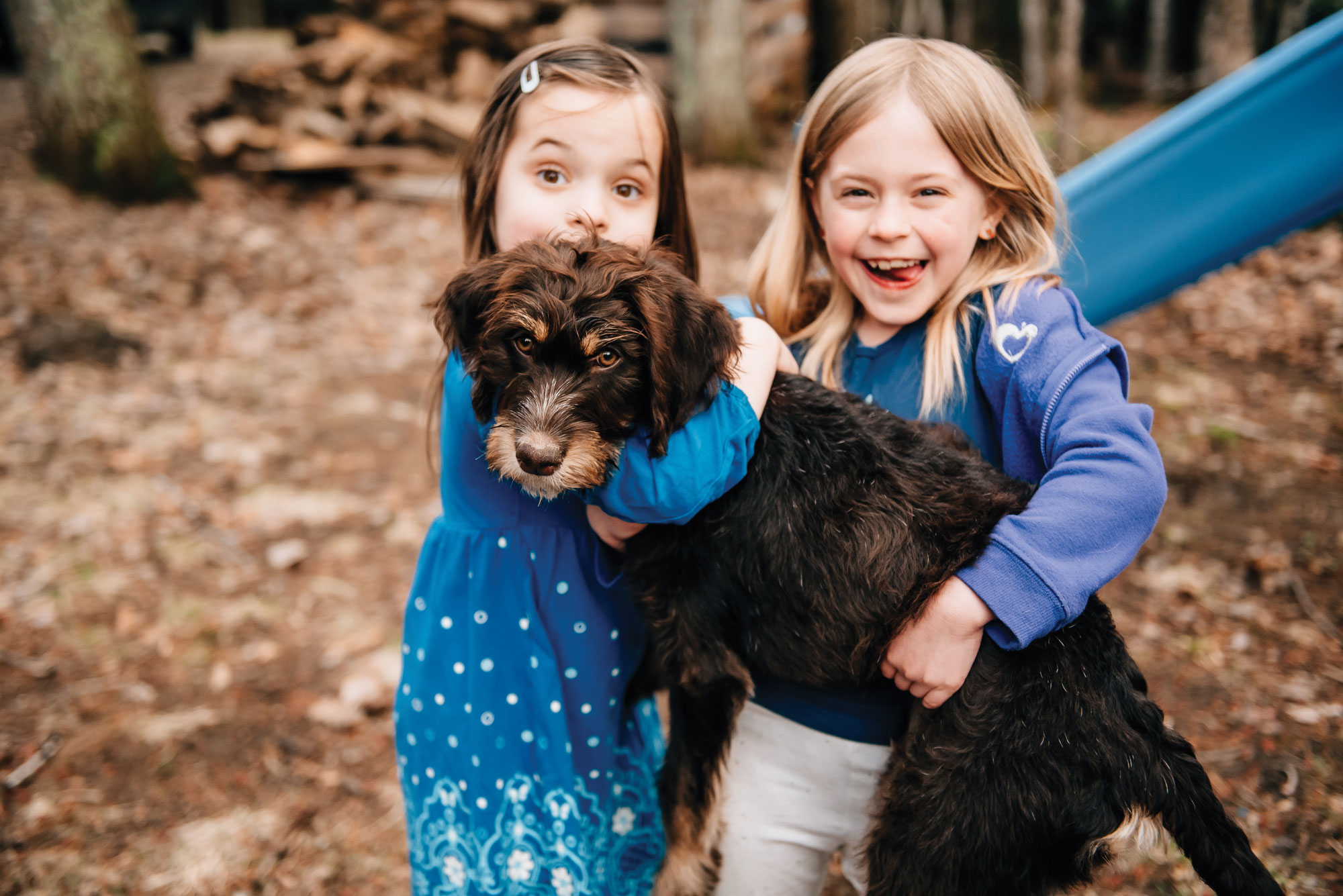HOMEWARD



From our July 2019 issue
HOMEWARD
Make a new canine friend in Maine and chances are good she’s from down south, as the dog-crazy Pine Tree State is among the most common destinations for southern rescue dogs. To understand why — and how they arrive — Kathryn Miles joined 37 very good dogs on a 1,600-mile road trip.
From our July 2019 issue
MILE 0
Early morning in central Mississippi. The sky hangs low and leaden. Thirty-nine-year-old Heather Hobby is dressed in running tights and a long-sleeve black tee emblazoned with the logo of her LLC, True North Animal Transport. An emergency-room imaging tech by trade, she’s just come off a marathon week of 12-hour shifts and has slept three, maybe four hours since yesterday. Despite this, her hair and makeup are runway perfect.
Hobby is running laps between her low-slung house and gleaming-black Ford Transit, her arms filled with blankets and bath towels, packing for her monthly 1,600-mile drive to Maine. Google says it’s a 26-hour trip. For Hobby, who shares her van with some 40 homeless dogs of varying ages, temperaments, and needs, the journey tends to take at least 36.
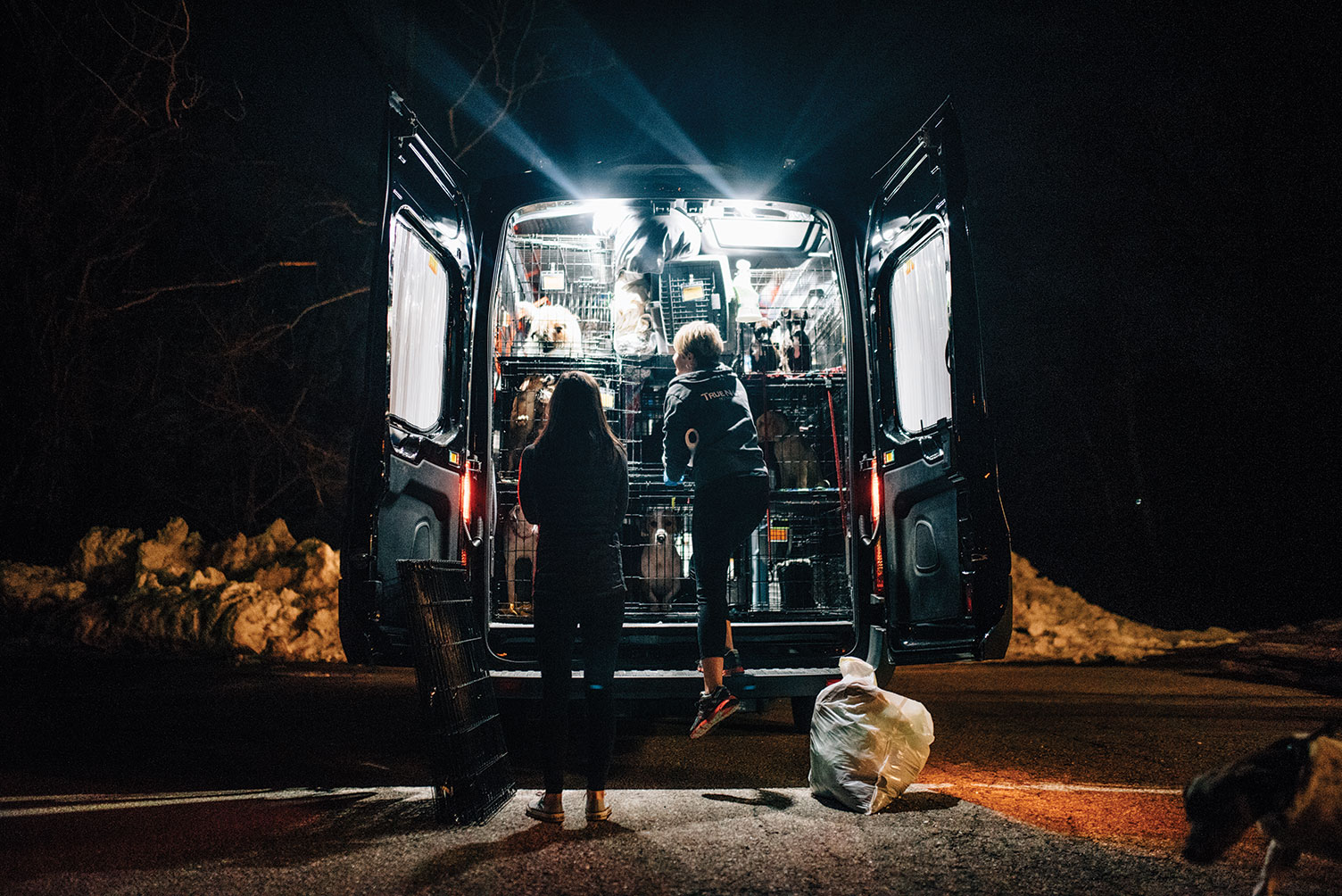
She wants to be on the road by afternoon, but Hobby still has travel certificates to file and vaccination records to gather. What’s more, one of her Maine quarantine stations hasn’t returned her calls, leaving her to wonder just where she will deliver several of her dogs. Meanwhile, word has it that two of the hounds scheduled to make the trip awoke this morning with diarrhea, and since a viral infection could be to blame, Hobby won’t chance taking them out of state. A third dog, blind and in late-stage renal failure, has been deemed too critical to survive the trip to a hospice center in Tennessee. So now there are crates to rearrange and three additional foster homes in Mississippi to secure — all of which has to wait until Hobby can remember where she put her cell.
Inside the van are metal crates stacked three high. Hobby lines each of them with linens, then adds metal water bowls. In the remaining cargo space, she stashes supplies she’ll need between here and Maine: huge bins of puppy food, rolls of industrial garbage bags, boxes of latex gloves, and a whole pharmacy’s worth of veterinary meds. Up front, she sandwiches a shopping bag overflowing with crackers and peanuts and energy bars among a tangle of cords and chargers, a pair of Bean boots, a few neck pillows, and a wooden angel to watch over her. Behind the van’s side door, she wedges her acoustic guitar and a bottle of blue prosecco. Probably she won’t have time for either, but who knows?
Finally, Hobby strings a hammock across the narrow aisle of space left in the cargo hold, alongside the dog crates. At least two more days of sleep deprivation await, and any sleep she gets is going to happen right here. Because if there’s one thing about which the certified animal transporter is emphatic, it is this: True North never leaves its babies. Never ever.
MILE 8
Heading east on Interstate 20, Hobby fishes for a radio station that will play both Reba and Kelly Clarkson. She fidgets in her captain’s chair, slugging tepid coffee and telling me stories about the plight of dogs in the Deep South. She is animated and passionate and interrupts herself liberally to switch stories or point out spots where tornadoes have touched down.
On the outskirts of Jackson, she exits the highway, passes a few outlet stores, then zips across a nearly vacant parking lot towards a row of cars with a dozen people clustered in front. These are True North’s most trusted canine foster parents. Whenever Hobby yanks a dog out of a high-kill shelter, finds a box of puppies in a dumpster, or rehabilitates a sick or injured stray, these volunteers step up to house the animals until Hobby can bring them north. She calls them “my badasses.”
Hobby parks her Transit, hops out, and hugs several of the badasses. Reluctantly, they begin opening portable kennels, releasing shepherds and cocker spaniels, Dalmatian mixes and indeterminate mutts. Hobby places a paper band around each dog’s neck, indicating its name and sex. She hangs a corresponding tag on each kennel, then begins loading the dogs, smoothing out their blankets and towels as she does.

Nationally, some 3.3 million dogs enter shelters each year. Of these, says the ASPCA, around 670,000 will be euthanized.
In the back of one volunteer’s SUV is a large metal kennel holding four scruffy mixed-breed puppies, siblings, just 11 weeks old. They are quiet and curious, observing the scene through wide yellow eyes. Roaming freely in the back seat is their littermate, Tink, who has somehow duped her foster into believing she’s too delicate for the kennel. She’s half their size and five times as fierce, barking indignantly and shoving her nose through the headrests to stare down passersby.
Hobby rolls her eyes. “Y’all have ruined this little dog,” she says fondly.
“We’ve saved her,” the foster replies.
And it’s true. Tink is one of the lucky ones, a southern dog who has bested the odds more than once. Her mother, Gracie, a chocolate Lab who is also making the trip north, is still practically a puppy herself — barely a year old, Hobby estimates. A few weeks before she was due to give birth, Gracie’s humans abandoned her at a high-kill shelter in Louisiana. Like many shelters in the South, it was built by a local animal control agency more than 50 years ago and intended only as the most temporary of holding facilities, a place where stray dogs and cats were held for a day or two before being claimed by their owners or, more likely, killed by lethal injection or by gas (usually carbon monoxide or dioxide, piped into a box that sometimes contains multiple animals). Today, these and other southern shelters aren’t much better prepared to care for unwanted animals.
Nationally, some 3.3 million dogs enter shelters each year, according to the American Society for the Prevention of Cruelty to Animals. Of these, says the ASPCA, around 670,000 will be euthanized, and animal welfare experts agree that the highest rates of euthanasia are in the South, where studies report kill rates of up to 30 percent. Some experts, like Phil Bushby, endowed chair of humane ethics and animal welfare at Mississippi State University’s College of Veterinary Medicine, believe those estimates are conservative.
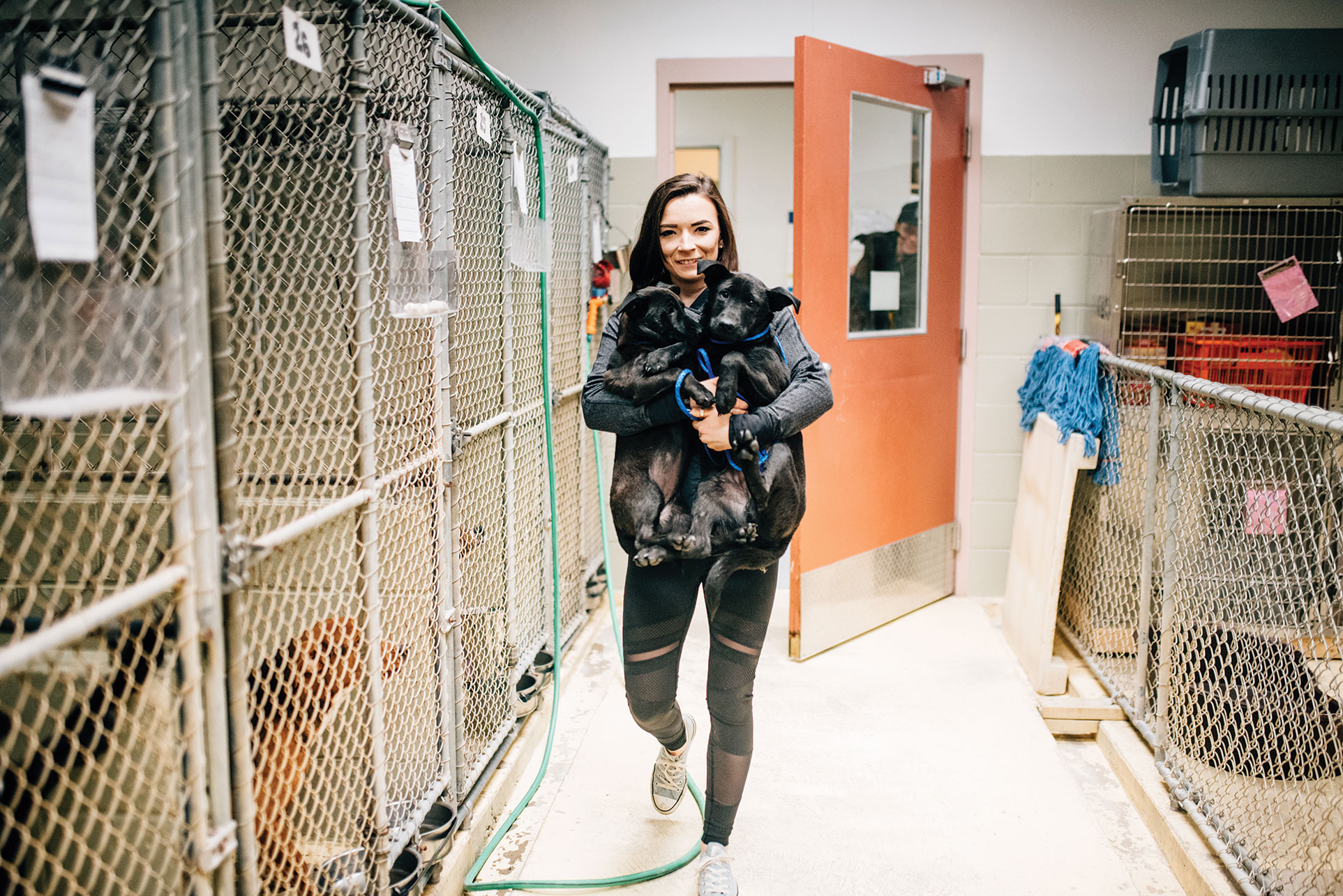
“One of the most dangerous places for an animal to live is a southern animal shelter,” Bushby says. “What we see again and again is minimal vet care and lots of overcrowding. The spread of infectious disease is great, and there’s not enough staff to socialize animals that were bred to want and need us.”
In the Deep South, where cultural attitudes that view dogs as property still hold a lot of sway, many dogs are never taken to a veterinarian, let alone spayed or neutered. Others are left to roam or discarded when their value as a hunting or retrieving dog diminishes. As a result, even well-run shelters often can’t keep up with the torrent of animals. In 2005, Bushby says, his own local humane society built a state-of-the-art shelter that was filled beyond capacity within a week. Until recently, it had no full-time vet on staff and didn’t provide spay and neuter services.
Gracie’s Louisiana shelter was overcrowded, its dogs kept in small concrete pens separated by chain-link fencing. In a single day, the shelter might receive 20 new dogs and have nowhere to put them, so arrivals are immediately sorted into those that will live and those that will die. As an owner-surrender (not a stray, whose owners may come looking), Gracie was already high on the kill list, and pregnant dogs are notoriously difficult to place with adoptive families. If she survived to give birth, her litter would place burdens on the shelter: she’d need a clean space to whelp, medical care, and up to 15 cups of food a day while she nursed her pups.
For all these reasons, dogs like Gracie are often euthanized shortly after arrival. Unless they land on the radar of people like Heather Hobby.

Gracie’s weaker pups sometimes went hungry, and Tink was the weakest of them all. The foster found her alone in the whelping box more than once, cold and unresponsive.
Within the networked world of southern dog-rescue organizations (Mississippi alone has more than 50), Hobby has earned a reputation as someone who’ll go the extra mile — sometimes hundreds of miles — for a doomed dog. So she wasn’t surprised to get a Facebook message from a concerned shelter worker telling her Gracie was on borrowed time. She summoned her foot soldiers: a volunteer in Louisiana retrieved Gracie and brought her to a driver, the driver brought her to Mississippi, and Hobby herself drove the Lab to a temporary home in Florida, four hours southeast, where Gracie almost immediately delivered a huge litter: 14 puppies.
With more puppies than teats, Gracie’s weaker pups sometimes went hungry, and Tink was the weakest of them all. The foster found her alone in the whelping box more than once, cold and unresponsive. She warmed Tink up with heated blankets and fed her drops of Karo Syrup to enliven her. But by the time her siblings weighed 5 pounds, Tink came in at barely a pound.
A New England native, Gracie’s foster knew that the brood’s best chance for adoption was in the Northeast, in a state like Maine, where robust spay and neuter laws, among other factors, have created a demand for dogs that regularly outstrips supply. So she brought the dogs back to Mississippi, where they were split up among a group of Hobby’s badasses — including Tink’s foster, a woman named Janet Gober — to await Hobby’s next shuttle north.
“It literally takes a whole damn village to save these dogs,” Hobby says, laughing as she loads Gracie and her puppies into their crates. Gober coos and preens over Tink, promising the little dog she will soon find her “forever home.” But Hobby cuts this short. She has little patience for sentimental goodbyes, and for her, this drill is routine — last year alone, she brought more than 600 dogs to New England, most to Maine or Rhode Island. And with 25 dogs now loaded and complaining loudly in her van, it is definitely time to go.
Tink, center photo, left, and others from her litter, wait outside during an off-load. A female dog in heat can be impregenated by more than one male, and Tink’s litter was likely sired by several fathers.
MILE 33
The gentle rocking of the cargo van on the highway has a sedating influence on the dogs, but it isn’t long before we’re exiting again, this time at a rural veterinary clinic, with a boarding facility, that gives Hobby discounts on vaccinations and neutering. Inside, we wait while the vet techs round up our next 11 passengers: a female basset hound and her four pups, a full-grown Lab, a one-eyed mongrel, an elderly Chiuhahua, and a trio of stubby black puppies recovering from a pernicious case of mange.
Once they’re loaded, Hobby checks her balance with the clinic’s manager. It’s not uncommon for True North’s bills here to run well into the thousands of dollars. Conditions like heartworm and parvovirus are common in the South and expensive to treat. Dogs often turn up at veterinarians shot or beaten, with broken legs and infected wounds. So long as she has room, Hobby accepts every one, no matter the cost of saving them.

Last year alone, Heather Hobby brought more than 600 dogs to New England, most of them to Rhode Island or Maine.
But even a perfectly healthy rescue dog is expensive to bring north: in addition to mandatory spaying and neutering, most New England states require a full complement of vaccinations. Maine rescues also require fecal tests, proof that dogs are parasite-free, and wellness checks by licensed veterinarians. Those vet visits alone can cost $200 per dog. Once in Maine, transported dogs are required to sit a multi-day quarantine at an approved veterinary hospital or with an approved foster.
All of this takes time. A puppy on Hobby’s manifest may need to wait three weeks or more to receive its required vaccinations and procedures. That means it will need a month of food — sometimes donated, often paid for by Hobby — while the dog stays with one of her fosters. Once on the transport, the dog accrues fuel expenses and the costs of supplies (not to mention the cost of the van itself, which Hobby bought out-of-pocket). Some northern groups who receive Hobby’s dogs reimburse True North for expenses, but not all. To pay the rest of the bills, Hobby hustles donations on social media or simply dips into her savings.
Back on the interstate, we drive past towns with names that ring distinctly Southern to my ears: Pelahatchie, Hickory, Chunky. Billboards tout fried catfish and Christian salvation. The scene beneath them is often grim: We pass dead dogs lying below overpasses or in ditches. Tattered pit bulls trot dangerously close to whizzing traffic. After we pass our third dead dog in 30 minutes, I ask Hobby how she manages to stay afloat, psychologically.
“I know I can’t save them all,” she says. “I just swim as fast as I can and accept that the ocean will take the rest.”
Hobby has always felt empathy towards animals. She grew up surrounded by them on a Mississippi cattle farm, where her family also rehabbed whitetail deer. But it was only seven or so years ago that she realized saving animals was her calling, after a visit to the vet with her epileptic pet dachshund, where she encountered a dog facing euthanasia after being dragged behind a truck. In 2015, she volunteered to drive a van full of dogs for a Mississippi transport organization that was down a driver. She got licensed as a transporter by the USDA, and although dogs are her passion, she has since schlepped lemurs, kangaroos, and red pandas for various rescue orgs and zoos. She once drove a threatened South Asian sloth bear from California to Massachusetts, nervously slipping grapes into its cage to keep the large animal hydrated cross-country.
She’s lost track of how many trips north she’s made, but Hobby estimates she has delivered dogs by the thousands.
Some leave indelible impressions. Like Zeus, a border collie mix who was shot and left for dead. He tried to drag himself home, wearing down his paralyzed back legs to bloody stumps. Or Conway and Loretta, two strays so bonded to one another that, after being rescued, Loretta hopped a fence and traveled 3 miles to return to the dump where the two had lived together.
Hobby calls these the “Hail Mary” cases, the ones requiring an extra high level of badassery to achieve anything close to a happy ending. Often, the happy ending doesn’t arrive in time. Just often enough, badassery prevails.

MILE 222
On the outskirts of Birmingham, Alabama, Hobby stops at a gas station to fuel up and collect our 37th dog, an overweight chocolate Lab. As we load her in, a middle-aged woman in an ancient Oldsmobile sputters up alongside us and asks if we have any Dobermans for sale — her boyfriend has always wanted one.
Meanwhile, the dogs, lulled by travel, start to reanimate, their din growing as we fill water dishes from plastic jugs. Tink and Gracie’s sharp barks cut loudest through the thick Southern air. No food yet: in Hobby’s experience, rescue dogs are particularly susceptible to motion sickness, and it’s a while yet until anyone’s getting fresh bedding.
We’re 10 miles out of town before the dogs start to settle again. Ten miles becomes 20 becomes 200. Hobby loves to speed and hates gridlock. She grimaces when we hit commuter traffic near Chattanooga. Looking out the window at the Southern Belle Riverboat, lazing down the Tennessee River faster than we can drive, she unleashes a string of imaginative invectives. (“Don’t write that down,” she jokes.)
As the traffic thins and the sun dips, she regains her sweet effervescence, chatting on speaker with a few favorite foster parents. They gossip about the dogs on board. Gracie, they all agree, is a hooligan; Tink, a total diva.
Later, when she’s off the phone, I ask whether she’s ever considered simply moving to Maine, or to someplace she’d encounter less of the animal cruelty and neglect she sees at home. She’s fantasized about it, Hobby admits, about finding some acreage on the midcoast and opening a sanctuary where unadoptable animals can simply be themselves. I ask her, why not do it?
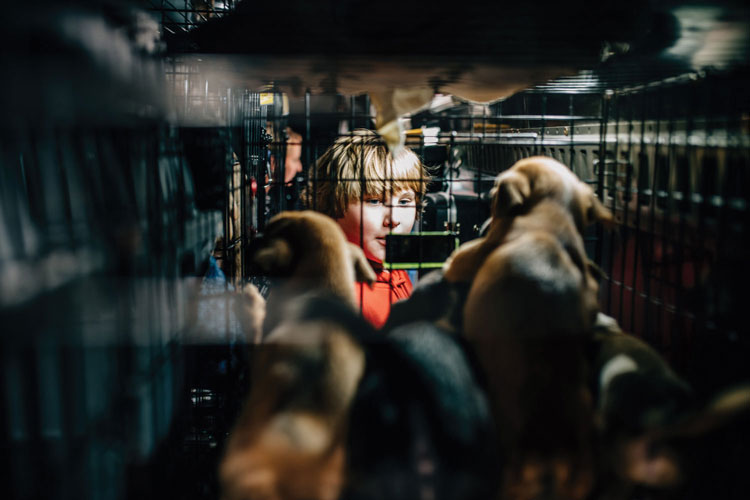

“Because then I think about all the dogs that have been tossed out, all the old dogs and the blind dogs that have no one, and I think this is about saving everyone we can,” she says. “Besides, at heart, I’m really just a southern stray.”
Somewhere in Tennesee, we pull in behind a big-box store, where the sulfurous glow of security lights illuminates a patch of grass between pallets of lawn fertilizer and the back entrance of a neighboring hospital. Hobby lays down two disposable painter’s tarps and unfolds a squat metal corral on top of each. Inside, she stacks absorbable training pads.
We unload the puppies in threes and fours and fives, ushering them into the commode corrals. This is nothing short of pit-crew work. Tink demands to be held, and I give in. In the van, Hobby transfers soiled towels and blankets into an industrial garbage bag, then swabs out each crate and installs new bedding. Puppies who’ve had an accident en route are rubbed down with baby wipes, then returned to their crates. A store clerk on the closing shift pushes a garbage cart off the nearby loading dock. He looks at us with something between curiosity and suspicion but doesn’t stop.
When the puppies are situated, Hobby and I take each older dog for a few loops in the grass, then everyone gets a handful of food and more water. Gracie immediately overturns her dish, soaking her fresh blankets. Hobby sighs and gets new ones. All told, the off-load takes 57 minutes.
We zip down the road to a gas station for $72 worth of diesel and the trip’s first bathroom break for humans. We’ve been on the road nearly eight hours. On the way out, Hobby buys a couple of peach-flavored Red Bulls but bypasses a fast-food counter selling burgers and loaded potatoes. Surely, I say, she must be starving by now.
“It doesn’t seem fair to have a meal or get in the van smelling like food when the dogs haven’t really had any,” she says.
Back on the road, we share a jar of peanuts as we drive. The interstate is empty but for a few 18-wheelers. Somewhere in the Shenandoah Mountains, long after I’ve dozed off, Hobby pulls into a truck stop for a catnap. I wake just long enough to help her cover the windshield, and soon, all 39 of the van’s occupants are sound asleep.


MILE 947
Come 7 a.m., we are in Hagerstown, Maryland, following a dusty school bus past shotgun houses and trailer parks, looking for a site for our next off-load. Hobby doesn’t like the look of the neighborhood: she hates attracting attention, especially in rural areas or places where she worries about crime.
We find our way to a vacant field next to an abandoned factory, where we repeat the previous night’s routine. Then Hobby gets out her cell phone to take portraits of several dogs and text them to the northern rescue groups awaiting their arrival. A few pups are already spoken for, but most are still available for adoption through the rescue groups that partner with True North.
More than 7,000 rescue dogs were brought to Maine last year — and Hobby was far from the only one bringing them. On average, southern states now transport about 30 percent of their stray and unwanted dogs out of state. Mississippi leads the nation with 39.3 percent of its shelter population transferred away, mostly to the Northeast. Many dogs arrive packed into tractor-trailers, with straw-and-wood-chip bedding their only relief during a nonstop trip. Others arrive via hand-off relays in cars driven by volunteers or, in some cases, in private planes lent to the cause by their pilots. Hobby has found a sweet spot that many of her northern partners appreciate, an operation small enough to provide stops and individualized attention but still large enough to rescue dogs by the hundreds.

Gracie paws at the snow, and then begins leaping in the air, again and again, spinning with delight. I tell her she is going to love Maine.
Upon arrival, many rescue dogs are immediately placed into state-approved foster homes arranged by rescue groups to await adoption. Others arrive at shelters like the one run by the Animal Refuge League of Greater Portland, which works with 60 rescue organizations to import dogs from across the globe. Each day, hopeful owners queue up by the dozens at their facility in Westbrook, sometimes hours before the shelter opens. Meanwhile, foster-based rescue groups can be beset by multiple applications from around the state for a single dog, even before she arrives.
It wasn’t always this way, says Animal Refuge League director Patsy Murphy. Much like those southern shelters, her organization was founded in 1911 with a mission of temporarily holding animals until they were retrieved or euthanized. “Maine was very much an agrarian state with agrarian values,” she says. “Domestic animals were considered property or commodities.”
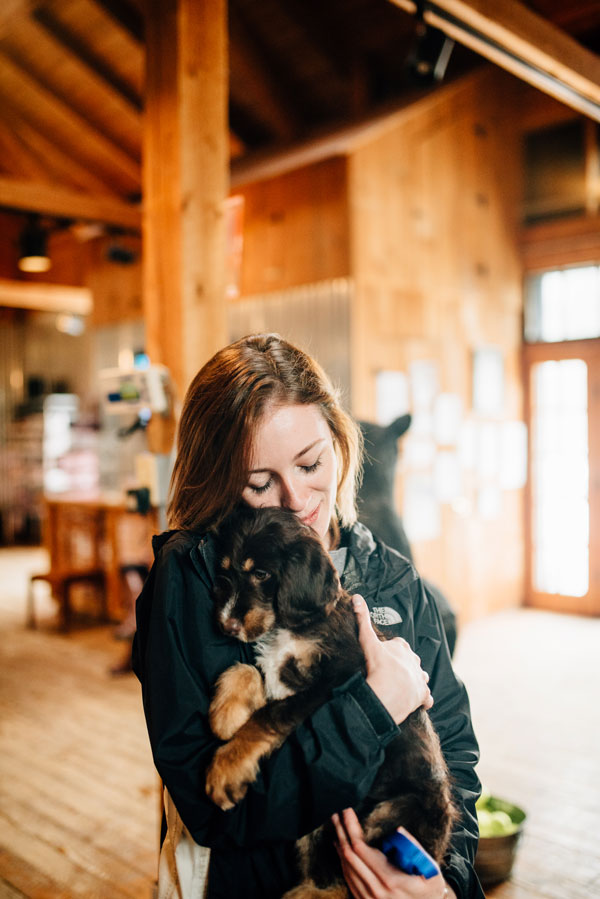
But as the state became more industrialized, that perspective changed. No longer work animals, dogs became card-carrying members of our families, and state laws evolved to reflect the new mindset. All dogs in Maine must be licensed. Campaigns promoting spaying and neutering took off aggressively in the 1980s, and in 2007, the state mandated sterilization for adopted animals (unless it endangers their health), with both the state and private groups establishing funds to offset costs for low-income families. In the past 50 years, the state has also toughened punishments for animal neglect and cruelty — both can incur fines twice as high as in states like Mississippi and can include jail time — while the adoption of microchipping and GPS collars means lost dogs have a much easier time finding their way home.
Today, Maine shelters boast a live release rate over 95 percent, with only about 3 percent of all animals euthanized, a rate that’s among the country’s lowest. With this success story has come an unexpected problem: in the 1990s, hopeful families started arriving at shelters like the Animal Refuge League to find no dogs left to adopt.
The region’s lack of dogs helped give rise to rescue groups and transporters like True North, and the subsequent advent of websites like Petfinder turbocharged rescue-dog trafficking. Today, rescue groups and hopeful adopters can search over 25,000 animals at any given time. Both individuals and organizations like the Animal Refuge League of Greater Portland can track down adoptable dogs in the South — or in places as far away as Turkey and Puerto Rico — and facilitate their arrival in Maine via transporters like Hobby. And Hobby can take to Facebook, posting pics of the dogs in her care so that one of her northern partner groups might claim them and facilitate their adoption.
After Hobby finishes her impromptu photo shoot in the Hagerstown field, we load up the dogs. In another 8 miles, we cross into Pennsylvania, passing a sign on an overpass marking the Mason-Dixon Line.
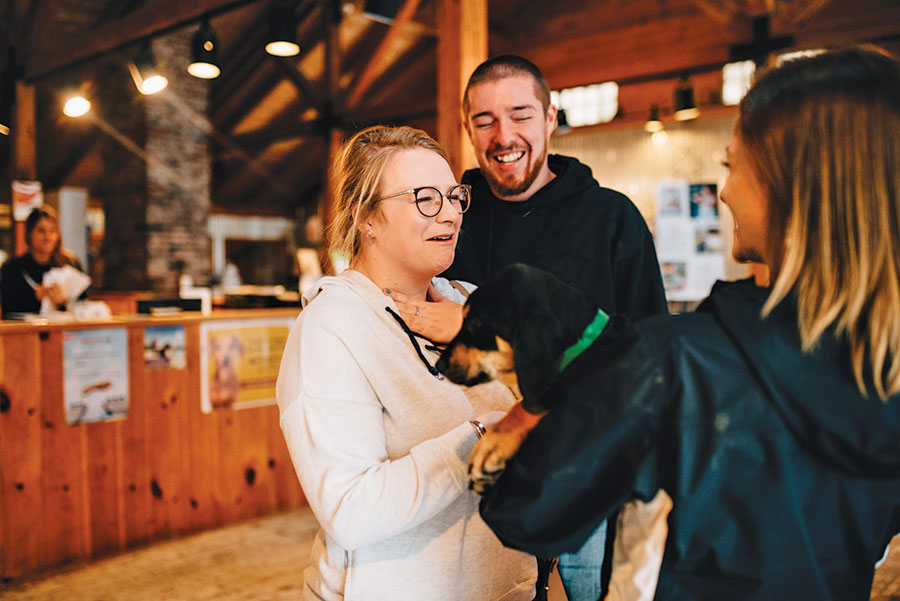

Fosters and adopters show up to receive Hobby’s passengers upon their arrival in midcoast Maine. Potential Maine adopters can find a southern dog online and arrange for its adoption through a rescue group.
MILE 1441
Somewhere in eastern Massachusetts, the dogs grow tetchy. They’ve slept through Amish country, tolerated New York City rush hour, and waited patiently as five of their companions were unloaded in Rhode Island. But now, 34 hours into the trip, the remaining 32 dogs have had it. They’re scratching at their crates and yowling. Hobby tries blasting the A/C. She plays a David Gray album — the singer-songwriter almost always calms them down, she says. But the dogs aren’t having it. Still an hour from our next scheduled stop, Hobby calls an audible.
We pull into the New Hampshire Welcome Center. It’s dark and very cold. Hobby pulls soiled blankets and tries to placate puppies in their crates. I walk the older dogs, two at a time. Gracie seems particularly glad to be out. When we find a patch of spring snow behind a picnic table, she is initially alarmed. She looks at me, then back at the snow. She paws at it, and then begins leaping in the air, again and again, spinning with delight. I tell her she is going to love Maine.
Back in the van, Hobby hands me some freeze-dried okra. We cross the Piscataqua River into Maine and arrive at the Kittery Animal Hospital in Maine’s southernmost town just after 10 p.m. Two of Hobby’s rescue partners are waiting there to help unload the nine dogs that will stay in specially designated quarantine runs behind the clinic. The rest get another off-load, and Tink once again finds her way out of the potty corral and into a rescue volunteer’s arms.
When we’re through, Hobby takes the van back across the river to park at her regular truck stop outside Portsmouth, New Hampshire. She’s wired. The dogs are wired. It takes a long time for anyone to fall asleep.


At 6 a.m., Hobby’s alarm chimes. She grabs a duffle containing a towel, shampoo, eyeliner, and a fresh True North T-shirt. The employees at the truck stop know her. They get hugs and a heady dose of southern drawl. Hobby lets me buy her a breakfast sandwich — the closest thing to a meal she’s eaten in two days — and she picks at it behind a big-box store as we off-load the dogs one last time.
At our next stop, a park-and-ride in Scarborough, Hobby meets a young couple who’ll be fostering the two Dalmatian mixes. Their beloved dog died a year ago. Fostering is a way for them to get comfortable with the idea of another long-term canine relationship.
“We’ve never had two at once,” the wife says nervously, crouching down to meet the siblings.
“You’ll be fine,” Hobby assures them.
Our terminus is another 120 miles up the road, at Maine Coast Animal Rescue, headquartered at a veterinary office in the small seaside town of Northport. I expect Hobby to be giddy, but she’s uncharacteristically quiet during the remaining miles. Last summer, Kristen McKellar, one of MCAR’s most enthusiastic staff members, and one of Hobby’s closest friends, was struck and killed by a speedboat while swimming in a lake. She was, Hobby says, the lifeblood of the rescue organization. An empty crate in the back of the van contains a charcoal sketch of the 32-year-old animal lover, famous around Maine’s rural midcoast for taking her rescued pit bull on motorcycle rides and working carpentry jobs with a squirrel perched on her shoulder.
In Northport, Danielle Blake, MCAR’s board president, is waiting for us. She hugs Hobby, then hands her friend a Bloody Mary, complete with a large celery stalk — a longtime tradition upon Hobby’s arrival — and the two head inside to sort through paperwork for the remaining 21 dogs in the van. Before she leaves me in the vet’s palatial waiting room, Hobby gives me a smile.
“Things are about to turn into Christmas morning around here,” she says. “Just watch.”

Fifteen minutes later, the first in a stream of adoptive families arrives to meet their new dogs. They include a 10-year-old boy with hearing loss. He and his mother have driven nearly 100 miles from Mechanic Falls, in western Maine, to see the basset hound’s four puppies. Hobby comes out with Blake and invites the boy inside the van to meet the puppies. He emerges a few minutes later, snuggling the smallest of the litter.
Is that the one? his mother signs.
Yes, he signs back. Thank you! He is beaming.
A 28-year-old woman from Bangor arrives with a photo of her puppy, printed off the MCAR Facebook page. “I’ll never let you go,” she says, tearfully, as he’s placed in her arms.
She’s followed by a couple planning to surprise their two children with one of the puppies from Gracie’s litter. A few approved fosters come in to claim others, some of them already predicting out loud that they’ll fall in love and adopt.
Thirty-two-year-old Kelly Harnden, of the nearby town of Belfast, arrives with her mom to meet Gracie. They sit on a bench, holding the Lab’s leash and scratching her belly. Harnden’s partner works offshore. They’ll have to wait until his drill ship returns to port before they can decide, but before she leaves, Harnden takes a long last look at Gracie over her shoulder.
By 3 p.m., all of Gracie’s litter has been claimed. Except for Tink, who sits alone in her crate, still inside Hobby’s van. She’ll spend her quarantine at the veterinary hospital and then be fostered by one of the technicians working there. As for her promised forever home?
“We’ll find it,” Blake says.
MILE 3204
Six days after leaving, Hobby arrives home in Mississippi with just enough time to pressure wash and disinfect her kennels before another weeklong shift at the emergency room.
A couple of days into it, she texts me a series of photos. The first few are of Gracie, at home with Kelly Harnden and her partner, who returned for her within days. The couple reports that she remains as rowdy as ever, still hates her crate, and loves tearing sheets and blankets off beds. But she has also turned out to be a great companion. The best photo of all is of the irascible Lab wedged between Harnden’s two young kids in the backseat of their car. Gracie is wearing the biggest doggie smile I have ever seen.
As for Tink, one of Blake’s volunteers texted her photo to a friend, Carly Kincaid, a vet tech at a midcoast Maine emergency hospital. One of the Kincaid family’s dogs had died a few weeks before. Carly took a look at the photo.
“It was all over,” she says. “I knew she was the one.”
Carly and her husband, Matt, live on a 12-acre farm in Appleton, a few miles inland from the shelter. They have two daughters, 7-year-old Mia and 5-year-old Georgia, plus an elderly Labrador named Sephus, a cat, and a flock of chickens. Tink has a new name — she’s Pippi now, as in Longstocking — and a job, working as a puppy ambassador at Carly’s clinic. She hasn’t quite figured out the cat or the chickens yet, but she loves to romp in the river near the farmhouse and to sleep with Mia and Georgia.
“She’s smart and hilarious and has a family who already adores her,” Carly says. “She’s perfect.”
